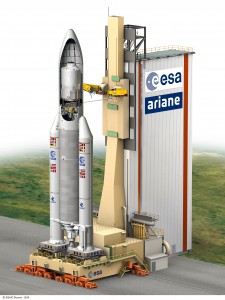In parallel the LRR also gave its OK – ATV is now formally cleared for launch on 15 February.
The latest report from ESA’s Charlotte Beskow in Kourou, received earlier today.
11 February 2011 D – 3: Two important milestones complete
Since I arrived in Kourou in mid-January, we have been rather lucky with the weather. The rainy season has started but in a gentle manner. The showers, up until the end of last week, have been intense but short and it has been possible to catch some relaxing moments by the pool from time to time.
All that changed a few days ago as heavy clouds rolled in from the Atlantic, accompanied by strong winds. Suddenly, everyone is carrying umbrellas. Actually it is probably a good business to sell umbrellas here since the wind will promptly turn them inside out. But with or without an umbrella you will get drenched during these downpours since the rain gets at you from all sides (a bit like in Noordwijk – where ESA’s Human Spaceflight team is based). Better to just wait it out. This means you do get unplanned (but welcome) breaks as you huddle somewhere, waiting for the squall to pass.
We had two important meetings this morning: the Launch Readiness Review (LRR) and the ISS Mission Management Team (IMMT) meeting with NASA. IMMT is a board that meets weekly to review upcoming activities on the ISS. This week’s IMMT was extra important since it would give an OK/NOK for ATV launch and docking to the ISS.
Many people had spent countless hours preparing for this to ensure that all was ready, that the various schedules matched up and that ATV would not pose any risk to ongoing ISS operations. I followed the IMMT (together with my ESA colleagues in Toulouse and Houston), while the rest of the team went off to the LRR.
The telecom starts, very professional, very quick, everyone well prepared; the Japanese and the Russian space agencies are also participating. Just before I am due to speak I hear on the CSG loudspeaker: “Attention a tous: test des sonorisations sauvegaurde, a ne pas prendre en compte” [‘Attention everyone: Test of the emergency public address system – please ignore’]. Oh no… they are testing the sound system simply to make sure we would hear a fire alarm !!!!
Two minutes later the beeping starts – and it is *loud*!! Good thing the mute button on the phone is ON. But if I unmute it to speak, then the IMMT teams listening in will jump through the roof. I quickly send a text to my colleagues in Toulouse and we arrange that they speak first if I am still sitting with my hands over my ears… The exercise finished in time though, and I could give my presentation.
It is quite tricky to give a presentation over the phone to people you cannot see – especially if you have never met them – but I followed the example of the previous speakers, trying to keep my speech short and to the point. In fact I sped through it so fast that the poor translator had no opportunity to speak. I had forgotten that everything needed to be translated into Russian. The listeners were tolerant though, and it all went smoothly. My ATV operations colleagues in Toulouse gave the next presentation – technical information had been exchanged in advance in order to clear up any questions and at the end, the OK was given.
It was quite exiting to sit there and hear the answer of each team as they were asked to give their GO / NOGO for ATV launch!
Another step along the road!
In parallel the LRR also gave its OK – ATV is now formally cleared for launch on 15 February.
Next step is the RAL, the last launcher review; this is an all-day event taking place on Sunday.
The piles of papers on our desks are getting smaller as we finish our actions – and outside the office, the packing crates have been brought into the main corridor, ready to be filled with material going back to Europe. Slowly but surely the end of this launch campaign is creeping up on us.
In Florida, Shuttle Discovery is getting ready for its launch. The date is tied to us, since they can only launch once ATV has docked. If we slip our launch, they slip their launch as well. Looking at the ISS traffic plan these days is a bit like checking the arrivals and departure screens at Schipol airport in Amsterdam – except that ISS planning is in colour and is much more exiting to look at.
— Charlotte


 Automated Transfer Vehicle page
Automated Transfer Vehicle page ATV blog archive
ATV blog archive
Discussion: no comments